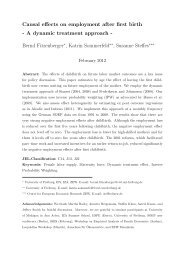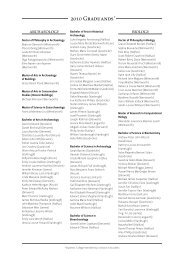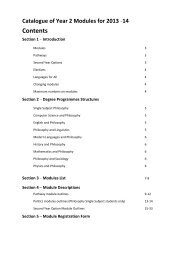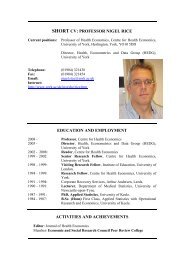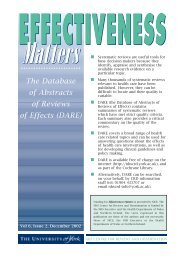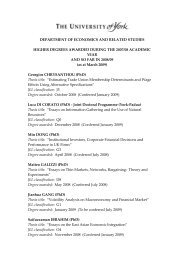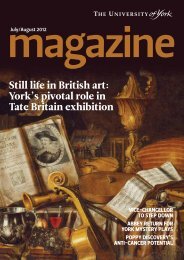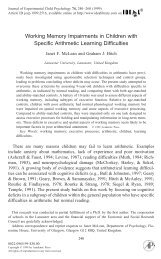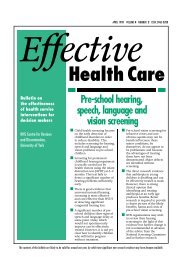Continuity of Christian practices
Continuity of Christian practices
Continuity of Christian practices
- No tags were found...
You also want an ePaper? Increase the reach of your titles
YUMPU automatically turns print PDFs into web optimized ePapers that Google loves.
1<strong>Continuity</strong> <strong>of</strong> <strong>Christian</strong> <strong>practices</strong> in Kent, c.410-597:a historical and archaeological review.John ClayWith its wealth <strong>of</strong> Roman remains, its proximity to the Continent and its comparatively earlyhistorical documents, Kent may be considered as one <strong>of</strong> the brighter corners <strong>of</strong> Dark AgeBritain. Yet this brightness is only relative. The story <strong>of</strong> the passage <strong>of</strong> Roman Kent to Englishkingdom resembles a thin soup, a mixture <strong>of</strong> ambiguity and cautious conjecture. New pieces <strong>of</strong>evidence have been dropped in now and then, and various flavours have been tried, but only themost general consensus has been reached as to what actually happened in Kent between the days<strong>of</strong> Emperor Honorius and Pope Gregory I.The traditional narrative was one <strong>of</strong> mass migration, wherein the various newcomers, inthe words <strong>of</strong> E T Leeds, ‘descended in hordes on the shores <strong>of</strong> Britain,’ 1 putting its inhabitantsto fire and sword, a view ultimately derived from the impassioned rhetoric <strong>of</strong> Gildas in his DeExcidio Britanniae. Thus Collingwood’s classic narrative is also structured around conflict andinvasion, 2 Evison’s 3 and Stenton’s 4 are the same, while Salway’s revision <strong>of</strong> Collingwood andAlcock’s studies both follow the same kind <strong>of</strong> route. 5 Morris’s model for the period is lucid and12345Leeds, T E, The Archaeology <strong>of</strong> the Anglo-Saxon Settlers (Oxford, 1913), 14.Collingwood, R G, Roman Britain (Oxford, 1932).Evison, Vera I, The Fifth Century Invasions South <strong>of</strong> the Thames (London, 1965).Stenton, Sir F, Anglo-Saxon England, 3 rd edition (Oxford, 1971).Salway, P, Roman Britain (Oxford, 1981). Alcock’s studies from the 50s to the80s were groundbreaking in many ways, but he always retained the interests <strong>of</strong>a military historian. See Alcock, L, Economy, Society and Warfare among theBritons and Saxons (Cardiff, 1987).
2insightful, but extremely historical and in focus. 6 In contrast, Frere uses the historical sources,particularly Gildas, with the utmost caution, but his framework for the end <strong>of</strong> Roman Britainremains essentially built around conquest. 7 Myres’ five phases <strong>of</strong> Anglo-Saxon pottery madetheir way across Britain in the wake <strong>of</strong> mercenaries. 8In recent decades some scholars, particularly archaeologists, have attempted to stir thefifth century soup and create a new picture. New theories have tried to create an alternativestory to that found in Gildas, and some have also stressed the extent <strong>of</strong> possible British survivalin ‘Anglo-Saxon’ areas. Whereas Wallace-Hadrill dismisses in half a paragraph the possibility<strong>of</strong> British influence on the Anglo-Saxons, 9 others take a different view. Detsicas, in his study<strong>of</strong> the Cantiaci, implies that some Romano-British institutions may have survived the coming<strong>of</strong> the Jutes, if not for very long. 10 Esmond Cleary, meanwhile, argues that the British, havinglost their Roman identity a generation earlier, ‘accepted the political, linguistic and perhaps alsoreligious systems <strong>of</strong> the incoming English.’ 11 Higham agrees with this, assuring us that ‘inadopting the material culture and language <strong>of</strong> the élite [the Britons] did no more than had theGallic peasantry <strong>of</strong> the Roman period.’ 126Morris, J, The Age <strong>of</strong> Arthur: A History <strong>of</strong> the British Isles from 350 to 650, vol1 (London, 1973).78Frere, S S, Britannia, 3 rd ed (London, 1987), 373-5.Myres, J N L, Anglo-Saxon Pottery and the Settlement <strong>of</strong> England (Oxford, 1969).9Wallace-Hadrill, J M. Early Germanic Kingship in England and on the Continent(Oxford, 1971), 22.101112Detsicas, Alec, The Cantiaci (Gloucester 1987), 184.Esmond Cleary, A S, The Ending <strong>of</strong> Roman Britain (London, 1989), 204.Higham, N, Rome, Britain and the Anglo-Saxons (London, 1992), 229.
3There has also been a swing towards the issue <strong>of</strong> British self-identity on the eve <strong>of</strong> theGermanic takeover. Michael Jones develops the notion <strong>of</strong> ‘de-Romanisation’, implying that itwas this process that allowed the Anglo-Saxons to achieve such dominance, and he usesarchaeological evidence to dismantle the old theories <strong>of</strong> massed Germanic migrations. 13Faulkner’s recent survey <strong>of</strong> Roman Britain gives the mixture another quick stir, this time addinga pinch <strong>of</strong> peasant warfare for good measure, but ends up with a similar flavour. 14 At the heart<strong>of</strong> the discussions centred on archaeological material is the issue <strong>of</strong> inferring ethnic identityfrom material remains, usually burials, and to what extent it is possible. Arnold makes this acentral concern <strong>of</strong> his textbook on the origins <strong>of</strong> Anglo-Saxon kingdoms. 15Esmond Cleary, frustrated at the difficulties <strong>of</strong> studying the period, has recently tried todrain the soup bowl ready for fresh, evidence-led research along well-defined ‘axes <strong>of</strong>inquiry.’ 16 I do not agree with his exclusion <strong>of</strong> the historical sources from his framework, whichis perhaps too extreme an act <strong>of</strong> purism even for an emancipated handmaiden; 17 my choice <strong>of</strong>1314Jones, M E, The End <strong>of</strong> Roman Britain (New York, 1996).Faulkner, N The Decline and Fall <strong>of</strong> Roman Britain (Gloucester, 2000).15Arnold, C J, An Archaeology <strong>of</strong> the Early Anglo-Saxon Kingdoms, 2 nd edition(London, 1997).1617Esmond Cleary, S, ‘The Roman to medieval transition’ in S James and M Millett(eds), Britons and Saxons: Advancing an Archaeological Agenda, CBA ResearchReport 125 (York, 2001), 90-97.C J Arnold used a similarly exclusive approach in his Roman Britain to Anglo-Saxon England (London, 1984), for which he was soundly criticised (see Myres’review in Britannia 16, 334). Since then, he has outlined a good model for thecomplementary use <strong>of</strong> archaeological and historical sources which has alsoinfluenced my approach in this essay; see Arnold, C J, ‘Territories and leadership:frameworks for the study <strong>of</strong> emergent polities in early Anglo-Saxon southernEngland’ in S T Driscoll and M R Nieke (eds), Power and Politics in EarlyMedieval Britain and Ireland (Edinburgh, 1988), 111-127.
4the significant dates <strong>of</strong> 410 and 597 to bound the review is deliberate in this respect. In part,however, the form <strong>of</strong> this essay is inspired by his framework. My aim is to focus our attentionon one aspect <strong>of</strong> the period which I believe is among the easiest to identify in the historical andarchaeological evidence: the practice <strong>of</strong> <strong>Christian</strong>ity. <strong>Christian</strong>ity is only one thread in the theme<strong>of</strong> continuity <strong>of</strong> British (if not Romano-British) identity into the medieval period, which in turnis only one part <strong>of</strong> understanding the period as a whole. But it will be interesting to attempt anevidence-led inquiry into a comparatively small and well-defined question, in the equally smalland well-defined area <strong>of</strong> Kent.Before looking for evidence <strong>of</strong> continuity, it is best to define what we are looking for,and from what it is continuing. In other words, a brief look at the state <strong>of</strong> <strong>Christian</strong>ity in lateRoman Britain is called for. The evidence can be summarised as follows. There are historicalsources which refer to bishops resident in major British cities during the fourth century, whoare known to have attended several Continental councils between 314 and 160. St Ninian isthought to have been active in Northern Britain around 400, and the heretical monk Pelagiuswas a product <strong>of</strong> late fourth century Britain; Germanus was despatched from Gaul to Britain tocombat his heresy in 429 and 447. Mawyer, examining 260 potentially <strong>Christian</strong> artefacts fromRoman Britain, concludes that 70 are explicitly <strong>Christian</strong>. 18 There are some famous <strong>Christian</strong>mosaics and wall paintings from Roman Britain, notably at Lullingstone (Kent), and Hinton St.Mary (Dorset), that, along with several treasure hoards, attest the existence <strong>of</strong> a privileged class<strong>of</strong> fourth century <strong>Christian</strong> landowners. There are the remains <strong>of</strong> possible Roman-periodchurches at London, Colchester, St Alban’s, Lincoln, Silchester, Wroxeter, Icklingham and18Mawyer, C F, Evidence for <strong>Christian</strong>ity in Roman Britain. The Small Finds(Oxford, 1995).
5Richborough.At present there is general agreement on the interpretation <strong>of</strong> this mass <strong>of</strong> evidence.<strong>Christian</strong>ity was, according to this view, essentially an élite religion, with little influence amongthe rural communities. Higham puts it thus: ‘The spread <strong>of</strong> <strong>Christian</strong>ity in later Roman Britainprobably owed more to its place in the Imperial system than to its inherent attractions to the bulk<strong>of</strong> the populace, most <strong>of</strong> whom remained pagan into the fifth century.’ 19 Watts follows thisview, highlighting the lack <strong>of</strong> a widespread parochial system, and the turbulence <strong>of</strong> the latefourth century that would have hindered the founding <strong>of</strong> such as system. She adds that British<strong>Christian</strong>s may also have remained closer to their pagan roots than did populations closer toRome. 20Most recently, Faulkner agrees that there is plentiful evidence to suggest a wellestablishurban episcopal network in the fourth century, and a <strong>Christian</strong> environment energeticenough to throw up a heretic like Pelagius, 21 but further than this he will not go. This generalview is reinforced by Constantius’s account <strong>of</strong> Germanus’s 429 visit.Now we are in a position to see what, if any, <strong>of</strong> this urban-based, episcopal, élite religionsurvived up to the arrival <strong>of</strong> Augustine. In terms <strong>of</strong> archaeology, I shall attempt to define thenature <strong>of</strong> material which can be taken as evidence for <strong>Christian</strong>ity. Burials are perhaps the mostobvious source <strong>of</strong> evidence, as it was here that the <strong>Christian</strong> identity was clearly expressed, and192021Higham, Rome, Britain and the Anglo-Saxons, 214.Watts, D, Religion in Roman Britain (London, 1998), 133-4. And even in Europe,the Church in later centuries had constant difficulties when it came to stampingout pagan <strong>practices</strong> amongst nominal (invariably rural) <strong>Christian</strong>s. See T. Reuter,'St Boniface and Europe', in T. Reuter (Ed.), The Greatest Englishman: Essayson St Boniface and the Church at Crediton (Exeter, 1980), 76; Dutton, P E,Carolingian Civilization: A Reader (Ontario, 1993), 3.Faulkner, Decline and Fall <strong>of</strong> Roman Britain, 118-9.
6they are the most common form <strong>of</strong> evidence to be excavated. There are late Roman burialgrounds which are taken as <strong>Christian</strong>, either because <strong>of</strong> associated <strong>Christian</strong> finds or because<strong>of</strong> a lack <strong>of</strong> goods and, sometimes, the presence <strong>of</strong> a west-east alignment. An absence <strong>of</strong> gravegoods and a west-east alignment are key signifiers <strong>of</strong> <strong>Christian</strong>ity. In terms <strong>of</strong> buildings, I willlook for evidence <strong>of</strong> churches, which should follow a typical late-Roman plan for suchstructures: rectangular, with an apsidal east end. Artefacts are an important source <strong>of</strong>information, as they can explicitly express <strong>Christian</strong> identity through symbols and words. Thecross is one such symbol, as is the Chi Rho and fish emblem. Place-names are <strong>of</strong>ten cited byarchaeologists as they sometimes hint at the existence <strong>of</strong> an ancient community or feature whichis now invisible to archaeology, so I shall also examine this evidence.To begin with burials, there are several large cemeteries in Kent which have beenextensively excavated, and which are thought to date from the fifth and sixth centuries. I haveexamined six which consist mostly or entirely <strong>of</strong> west-east inhumations: two near Dover, twoin the Darent valley and two near the mouth <strong>of</strong> the Medway. At Buckland, 22 Lyminge, 23Orpington 24 and Darenth Park, 25 the burials were almost entirely west-east in orientation(Orpington also included 19 cremations), and contained a great many grave goods. These foursites were interpreted as pagan Anglo-Saxon burial grounds on the basis <strong>of</strong> these grave goods,22Evison, V, Dover: The Buckland Anglo-Saxon Cemetery (London, 1987).23Warhurst, A, ‘The Jutish cemetery at Lyminge’ in Archaeologia Cantiana 69(1955), 1-40.24Tester, P J, ‘An Anglo-Saxon cemetery at Orpington’ in Archaeologia Cantiana83 (1968), 125-50.25Batchelor, D, ‘Darenth Park Anglo-Saxon cemetery, Dartford’ in ArchaeologiaCantiana 108 (1990), 35-72.
7and were dated from the mid fifth to late sixth century (with Buckland continuing as a <strong>Christian</strong>cemetery into the eighth).The earliest phase <strong>of</strong> Buckland was associated with a rectangular enclosure, whichEvison suspects may have contained a building; 26 unfortunately it was not excavated, so itsexact nature is unknown. At Lyminge, grave 39 yielded some interesting burial goods. Thewoman interred was wearing four low quality brooches, decorated with cross motifs. Warhurstpoints out similarities to non-<strong>Christian</strong> decorative motifs, favouring a pagan context for thebrooches. 27The only grave good recovered from these sites which was considered to beexplicitly <strong>Christian</strong> was a late Roman glass bowl inscribed with a Chi Rho, from Darenth Park.Batchelor is <strong>of</strong> the opinion that this item was recovered from its original context and kept bya pagan Saxon regardless <strong>of</strong> its religious connotations, 28 and this illustrates the problems <strong>of</strong>inferring ethnicity and beliefs from burials: Batchelor’s interpretation prevents the grave frombecoming a <strong>Christian</strong> anomaly in an otherwise wholly pagan burial site, and thus does not raisenew problems, but is not necessarily correct.The burials at Holborough 29 were aligned west-east, and contained very few grave goods.Evison’s conclusion was that they were <strong>Christian</strong>, dating from the late seventh century, fromthe last phase <strong>of</strong> an otherwise destroyed (and previously pagan) cemetery. The <strong>Christian</strong>interpretation was derived partially from an open-cross form buckle and another buckle with262728Evison, V, Dover: The Buckland Anglo-Saxon Cemetery, 152.Warhurst, Archaeologia Cantiana 69, 27.Batchelor, Archaeologia Cantiana 108, 61-2.29Evison, V I, ‘An Anglo-Saxon cemetery at Holborough, Kent’ in ArchaeologiaCantiana 70: 84-141.
8a fish design. 30 Nearby at Eccles 31 about 200 burials were excavated next to the site <strong>of</strong> a largeRoman villa, almost all aligned west-east, and mostly without goods. The site was interpretedas seventh century <strong>Christian</strong> Anglo-Saxon.Three <strong>of</strong> the cemeteries above are on the sites <strong>of</strong> former Roman villas, but none <strong>of</strong> themare interpreted as being <strong>Christian</strong> until after the seventh century Conversion. In fact, very fewthoroughly excavated villas have produced evidence for <strong>Christian</strong>ity even in the late fourthcentury, even if the site itself continued in use into the fifth. In Kent, villas that failed toproduce a hint <strong>of</strong> <strong>Christian</strong>ity are found at Orpington, 32 Keston, 33 and in the Darent Valley. 34 AtOtford, the only evidence for <strong>Christian</strong>ity is a fragment <strong>of</strong> wall plaster which may be part <strong>of</strong> alarge Chi Rho. 35 At Lullingstone, the late Roman chapel fell into disuse in the early years <strong>of</strong> thefifth century and was not recovered: rather, a post-Conversion church was built directly uponthe remains <strong>of</strong> a fourth century pagan temple and mausoleum, respecting its alignment. Meatessuggests that this is an example <strong>of</strong> Augustine having a pagan site ‘converted’ to <strong>Christian</strong> use. 36If this is the case, then memory <strong>of</strong> the early fourth century pagan temple outlasted memory <strong>of</strong>the late fourth century <strong>Christian</strong> chapel only yards away.3031323334Ibid, 152.Shaw, Rachel, ‘The Anglo-Saxon cemetery at Eccles: a preliminary report’ inArchaeologia Cantiana 114, 165-88.Philp, B, The Roman Villa Site at Orpington, Kent (Dover, 1996).Philp, B et al, The Roman Villa Site at Keston, Kent (Dover, 1991).Philp, B Excavations in the Darent Valley, Kent (Dover, 1984).35Meates, G W, ‘Early <strong>Christian</strong>ity in the Darent Valley’ in Archaeologia Cantiana100 (1984), 57-64.36Meates, G W, The Roman Villa at Lullingstone, Kent (Dover, 1979).
9On the matter <strong>of</strong> fifth or sixth century churches in Kent, the review is brief and concise: thereare no known remains <strong>of</strong> such buildings, either newly built or kept in use from the fourthcentury. Either we have failed to recover/recognise them, they are archaeologically invisible,or they were not built at all.In Copley’s survey <strong>of</strong> fifth and sixth century place-names, Kent claims 46. Of these, 13contain potentially British elements. 37 They largely refer to local rivers or geographical features,and only one may refer to <strong>Christian</strong>ity - Eccles, derived from Welsh eglwys and ultimately fromLatin ecclesia. The site <strong>of</strong> Eccles once had a Roman villa, as we have seen, and is associatedwith other Roman-period remains, including a major road. 38Yet Copley is sceptical aboutinferring the presence <strong>of</strong> <strong>Christian</strong>s from place-names, 39 and the example <strong>of</strong> Eccles is a case inpoint. There are only four examples from south-east England, 40 and this scarcity must mean thatit was not used much, or it was generally discarded at an early date. Morris 41makes theadditional point that the English had their own specific word for a <strong>Christian</strong> church, cirice,which was used from the fourth century on the Continent and has survived in English to thepresent day. There are no fifth or sixth century place-names in Kent which contain the ciriceelement.Sussex.3738394041Copley, G, Archaeology and Place-Names in the Fifth and Sixth Centuries,British Archaeological Report No. 147 (Oxford, 1986).Cameron, K, ‘Eccles in English place-names’ in M W Barley and R P C Hanson(eds), <strong>Christian</strong>ity in Britain, 300-700 (Leicester, 1968), 87-92.Copley, G, Early Place-Names <strong>of</strong> the Anglian Regions <strong>of</strong> England, BritishArchaeological Report No. 185 (Oxford, 1988), 3.The other three are Eccles in Norfolk, and Ecclesbourne and Ecclesden, both inMorris, R, The Church in British Archaeology, British Archaeological Report No.47 (Oxford, 1983), 45-6.
10This brief survey demonstrates that there is very little archaeological or place-nameevidence that <strong>Christian</strong> communities survived in Kent from the Roman period to the seventhcentury. There are no clearly <strong>Christian</strong> cemeteries which have been dated to before theConversion, there is no evidence for churches or for <strong>Christian</strong> artefacts being produced, andplace-name evidence is scarce. There are, however, problems with the evidence. If there werechurches being built by isolated Kentish communities, they would almost certainly not havebeen built in stone, which immediately prejudices against their survival in the archaeologicalrecord - indeed, there are very few structures <strong>of</strong> any kind known from this period and area.Secondly, almost all thorough archaeological work has been in the river valleys, where Anglo-Saxon influence seems to have been greatest, and hardly any research has been committed onthe upland areas <strong>of</strong> the Weald or Downs. Thirdly, there are the eternal problems <strong>of</strong> inferringethnicity and other socio-religious factors from burial remains. If Watts 42 is right in her assertionthat British <strong>Christian</strong>ity was comparatively diluted with pagan elements, it is unclear how thiswould affect burial rites. Finally, archaeology relies upon a generalised, potentially circulartheory <strong>of</strong> dating. Burials are dated according to their grave goods, so even if west-east burialswithout goods are found and designated <strong>Christian</strong>, they are automatically assumed to date fromthe post-Conversion period on this basis alone. This method also seems to prejudice theperception <strong>of</strong> evidence: it seems to me that Evison’s open-work (supposedly <strong>Christian</strong>) buckle 43bares only the slightest resemblance to a cross motif, whereas Warhurst’s four ‘pagan’brooches 44 are much more ‘<strong>Christian</strong>’ in appearance. By viewing the evidence through certain424344See above, note 20.See above, note 30.See above, note 27.
11eyes, it is made to strengthen a pre-conceived model. These are hardly new problems, but anevidence-led enquiry requires that each <strong>of</strong> our assumptions are picked apart and addressed.It now remains to examine the documentary sources for evidence <strong>of</strong> continued<strong>Christian</strong>ity. The key source for this is Gildas. Bede, Procopius, Zozimus, the Anglo-Saxon andGallic Choniclers, Prosper <strong>of</strong> Aquitaine and Nennius all mention Britain, but they are farremoved by time or distance compared to Gildas. As discussed earlier, archaeologists andhistorians have tended to agree on a rough narrative <strong>of</strong> events: that some Germanic mercenarieswere brought over the North Sea and given land in the south east, that the mercenaries rebelledand put to flight the British, and that there followed a prolonged period <strong>of</strong> wars that ended witha British victory and several decades <strong>of</strong> peace. The chronological construction <strong>of</strong> this sequence<strong>of</strong> events is the most commonly disputed element, but it is thought to run from the middle untilthe end <strong>of</strong> the fifth century. In an attempt to build a more stable framework, and acknowledgingBede’s own rather forced and artificial dating model, 45 historians have shifted various parts <strong>of</strong>the story around. Thus Thompson proposes that Gildas was narrating a northern version <strong>of</strong> theAnglian invasion, 46 while Miller suggests that the plea to Rome for help came from the north,while Hengest’s arrival was indeed in the south. 47 Chadwick Hawkes admits that while thesources do not lend themselves to confident interpretation, it could be that Hengest did indeedarrive in Kent, but that the Adventus Saxonum <strong>of</strong> Gildas was a separate event elsewhere in the26.454647Chadwick Hawkes, S, ‘Anglo-Saxon Kent c.425-725' in P E Leach (ed),Archaeology in Kent to AD 1500, CBA Research Report No. 48 (York, 1982), 65-6.Thompson, E A, ‘Gildas and the history <strong>of</strong> Britain’ in Britannia 10, (1979), 203-M Miller, ‘Bede’s use <strong>of</strong> Gildas’ in English Historical Review 90 (1975), 241-61.
12south east. 48When we consider that the basic details <strong>of</strong> the Anglo-Saxon arrival are so controversial,it is not surprising that the nature <strong>of</strong> the Anglo-Saxon takeover is even more obscure. Gildas’sview is uncompromising. He writes <strong>of</strong> the Saxon onslaughts:...All the major towns were laid low by th repeated battering <strong>of</strong> enemy rams; laid low,too, all the inhabitants - church leaders, priests and people alike, as the swords gleamedall around and the flames crackled. 49This was for a long time the accepted image <strong>of</strong> early cultural interaction between Britons andSaxons. The main point to make here regards Gildas’s mention <strong>of</strong> praepositi ecclesiae andsacerdotes. He perceived the conquest <strong>of</strong> the Britons by the Saxon invaders in explicitlyBiblical terms, a war <strong>of</strong> savage pagans against the misguided servants <strong>of</strong> Christ. His frequentquotations from Scripture demonstrate this:‘They have burned with fire your sanctuary on the ground, they have polluted thedwelling-place <strong>of</strong> your name.’ And again: ‘God, the heathen have come into your4849Chadwick Hawkes, ‘Anglo-Saxon Kent,’ 67.Gildas, ‘The Ruin <strong>of</strong> Britain’ in The Ruin <strong>of</strong> Britain and OtherWorks, ed. andtrans. M Winterbottom (London, 1978), 27; Ita ut cunctae columnae crebisarietibus, omnusque coloni cum praepositus ecclesiae, sum sacerdotibus acpopulo, mucronibus undique micantibus, ac flammis crepitantibus, simul solosternerentur. Gildas, De Excidio Britanniae. Ad Codicum ManuscriptorumRecensuit Josephus Stephenus, Publications <strong>of</strong> the English Historical Society(London, 1838), I.24.
13inheritance; they have desecrated your holy temple’; and the rest. 50Gildas had his own contemporary reasons for writing in this way. In order for this message towork, it has to be extreme both in its images and in its contrasts; thus we cannot be sure howfar the sweep <strong>of</strong> Saxon iron and fire was taking place in fifth century Kent, and how far inGildas’s head. 51Another fragment <strong>of</strong> Gildas worth mentioning is his statement that some Britonsremained in the country, in remote places where they were safer from the Saxons. 52 If this isbased on historical fact, it has clear implications for the survival <strong>of</strong> <strong>Christian</strong> Britishcommunities in Kent. Procopius states in a slightly garbled fashion that many Britons uprootedand emigrated to Francia, but he does not tell us where they came from, when they left, orexactly who they were. It is clear that the urban populations suffered greatest, being virtuallyextinguished. As Watts puts it: ‘Because the towns were early victims <strong>of</strong> the economic declineit is certain that the numbers <strong>of</strong> <strong>Christian</strong>s were reduced as the population dispersed into thecountry.’ 53 It seems quite likely that many Britons remained in lands taken over by the Saxons,especially given that the latter were almost certainly outnumbered many times over.50Gildas in The Ruin <strong>of</strong> Britain and Other Documents, 27; Incenderunt ignisanctuarium tuum, in terra polluerunt tabernaculum nominis tui. Et iterum divit:Deus, venerunt gentes in haereditatem tuam; polluerunt templum sanctum tuum,etc. Gildas, De Excidio Britanniae, I.24.51Higham, N J, The English Conquest: Gildas and Britain in the Fifth Century(Manchester, 1994), 203.5253Gildas, De Excidio Britanniae, I.25.Watts, Religion in Roman Britain, 135.
14Bede’s narrative for this period is largely derived from Gildas, with the polemic toned down butthe details retained. He also adds an account <strong>of</strong> the visit <strong>of</strong> St Germanus <strong>of</strong> Auxerre on his twomissions to combat the Pelagian heresy. Much has been made <strong>of</strong> this account and its source, theLife <strong>of</strong> St Germanus by Constantius. 54It is crucial evidence for the survival <strong>of</strong> British<strong>Christian</strong>ity after the end <strong>of</strong> Roman Britain, as it describes city authorities who apparentlyretained some <strong>of</strong> the garb <strong>of</strong> Roman authority, including <strong>Christian</strong>ity. However, it also tells usmuch about the nature and limits <strong>of</strong> British <strong>Christian</strong>ity. The people with whom Germanusdebates seem to be members <strong>of</strong> the aristocratic élite, well educated and influential - they werealso Pelagians, and the importance <strong>of</strong> Pelagianism in the British developments <strong>of</strong> this time isunclear; Morris believes that its political role was central in Britain’s rejection <strong>of</strong> Romanauthority. 55 The mass <strong>of</strong> the people, we are told, were in awe <strong>of</strong> Germanus’s charisma and piety- so much so that many desired to be baptised. There are two mass baptisms mentioned, and itwould seem therefore that the bulk <strong>of</strong> the rural population was not <strong>Christian</strong>. Indeed, theinsecure foundations <strong>of</strong> <strong>Christian</strong>ity led to Germanus’s second visit, to combat the sameproblem all over again. It would seem that <strong>Christian</strong>ity was indeed largely limited to the upperstrata <strong>of</strong> fifth century British society.Gildas was clearly literate, writing for a Latin-speaking audience; furthermore, hiswriting suggests that he had undergone some form <strong>of</strong> traditionally-derived Latin education,perhaps on the Continent like St Patrick. 56 The eleventh century Life <strong>of</strong> St Cadoc alludes to a1954).545556In translation, see Constantius in Hoare, F R, The Western Fathers (New York,Morris, The Age <strong>of</strong> Arthur, 71-2.Chadwick, N K, ‘Introduction’ in N K Chadwick, K Hughes, C Brooke and KJackson (eds), Studies in the Early British Church (Cambridge, 1958), 1-28;
15Welsh tradition <strong>of</strong> a famosus rethoricus coming to Wales from Rome during the sixth centuryin order to teach the British correct Latin, 57 and Faustus <strong>of</strong> Riez went in the opposite directionin the early fifth century. 58 Although these sources are very late, the British church was certainlynot entirely isolated during this earlier period, although certain aspects <strong>of</strong> its liturgy and customsdo seem to have later become archaic compared to Continental <strong>practices</strong>. 59Meens 60 has argued that elements <strong>of</strong> the British church survived in Kent until the arrival<strong>of</strong> Augustine, and that they w ere deliberately written out <strong>of</strong> history by the Venerable Bede,whose antipathy towards the British church is clear in his Ecclesiastical History. 61Meensexamines closely Pope Gregory’s replies to some queries <strong>of</strong> Augustine concerning matters <strong>of</strong>ritual purity. Some <strong>of</strong> Augustine’s questions were regarding menstruation and childbirth, issueswhich Meens argues were anachronistic to Gregory’s world. Attempting to define the source<strong>of</strong> these questions, Meens rules out pagan Anglo-Saxon culture or sixth century Gaul; the latterwas concerned with some matters <strong>of</strong> ritual purity, but only regarding sexual activity at certaintimes <strong>of</strong> the liturgical year, not childbirth or menstruation. He concludes that the most probableLapidge, M, ‘Gildas’s education and the Latin culture <strong>of</strong> sub-Roman Britain’ inM Lapidge and D Dumville (eds), Gildas: New Approaches (Woodbridge, 1984),47-8.5758596061Chadwick in Studies in the Early British Church, 7.Lapidge in Gildas: New Approaches, 47.For the palaeographical evidence, see Brown, J, ‘The oldest Irish manuscripts andtheir late Antique background’ in J Bately, M P Brown and J Roberts (eds), APalaeographer’s View (London, 1993), 221-2.Meens, B, ‘A background to St Augustine’s mission to Anglo-Saxon England’,in Anglo-Saxon England 23 (1994), 5-17.Brooks, N, ‘Canterbury, Rome and the construction <strong>of</strong> English identity’ in J MH Smith (ed), Early Medieval Rome and the <strong>Christian</strong> West. Essays in Honour<strong>of</strong> Donald A Bullough (Leiden, 2000), 221-246.
16origin was the British church, which was concerned with precisely these matters. 62If Meens is correct, and Augustine did encounter practising <strong>Christian</strong>s in late sixthcentury Kent who were descended from the <strong>Christian</strong> church <strong>of</strong> late Roman Britain, then theimplications for this topic are vast. There are, however, problems with his evidence: he uses avariety <strong>of</strong> British sources from the sixth to eighth centuries to support his argument, yet the onlysources which discuss the specific ritual matters <strong>of</strong> childbirth and menstruation are the laterones. The sources pre-dating the Augustinian mission do not mention them, and there is no realreason therefore to suppose that the influence <strong>of</strong> the British church was any more likely thecause <strong>of</strong> Augustine’s concerns than the Frankish church, which is known to have had influencein Kent at the time through Ethelbert’s <strong>Christian</strong> Frankish wife and her bishop Liudhard. 63I have attempted to sift through the lumps and fragments <strong>of</strong> evidence for the existencein fifth and sixth century Kent <strong>of</strong> some form <strong>of</strong> <strong>Christian</strong>ity. Although the material is tantalising,I do not believe it to be sufficient to state that there were British (or converted Anglo-Saxon)<strong>Christian</strong>s living in Kent at this time. It is true that the problems <strong>of</strong> evidence survival makethings worse for us, as always: the archaeological material is biased and limited, and trulycontemporary historical sources are non-existent. There are added problems <strong>of</strong> the interpretation<strong>of</strong> the archaeological evidence, most particularly dating, and our inability to positively identifya <strong>Christian</strong> even if we should one. Also, it must be remembered that Meens is not necessarilywrong in his argument, even if the evidence is not watertight.Lt-Col G W Meates was one <strong>of</strong> the giants <strong>of</strong> Kentish archaeology in his day. ‘People donot seem to realise,’ he w rote in 1984, shortly before his death, ‘that the history <strong>of</strong> <strong>Christian</strong>6263Meens in Anglo-Saxon England 23, 14.Stenton, Anglo-Saxon England, 105.
17worship begins [in the Darent valley] and has been practically continuous from the last decades<strong>of</strong> the fourth century to the present day.’ 64 I have tried to illustrate that the evidence as it standsrequires us to disagree with such a statement. For the time being, our broader theories <strong>of</strong>Germanic-British interaction from the mid fifth to late sixth centuries must assume that<strong>Christian</strong>ity had a negligible or non-existent presence in Kent.64Meates in Archaeologia Cantiaca 100, 59.
18BibliographyPrimary SourcesConstantius <strong>of</strong> Lyon. ‘The Life <strong>of</strong> St. Germanus’ in Hoare, F R (ed. and trans.). The WesternFathers: Being the Lives <strong>of</strong> SS. Martin <strong>of</strong> Tours, Ambrose, Augustine <strong>of</strong> Hippo,Honoratus <strong>of</strong> Arles and Germanus <strong>of</strong> Auxerre. New York, 1954: pp. 283-320.Gildas. De Excidio Britanniae. Ad Codicum Manuscriptorum Recensuit Josephus Stephenus.Publications <strong>of</strong> the English Historical Society. London, 1838.Gildas. ‘The Ruin <strong>of</strong> Britain’ in M Winterbottom (ed. and trans.). Gildas: The Ruin <strong>of</strong> Britainand Other Works. London, 1978: pp. 13-79.Secondary SourcesAlcock, L. Economy, Society and Warfare among the Britons and Saxons. Cardiff, 1987.Arnold, C J. Roman Britain to Anglo-Saxon England. London, 1984.Arnold, C J. An Archaeology <strong>of</strong> the Early Anglo-Saxon Kingdoms. 2nd ed. London, 1997.Arnold, C J. ‘Territories and leadership: frameworks for the study <strong>of</strong> emergent polities in earlyAnglo-Saxon southern England’ in S T Driscoll and M R Nieke (eds.). Power andPolitics in Early Medieval Britain and Ireland. Edinburgh, 1988: pp. 111-127.Batchelor, D. ‘Darenth Park Anglo-Saxon cemetery, Dartford’ in Archaeologia Cantiana 108(1990): pp. 35-72.Brooks, N. ‘Canterbury, Rome and the construction <strong>of</strong> English identity’ in J M H Smith (ed.).Early Medieval Rome and the <strong>Christian</strong> West. Essays in Honour <strong>of</strong> Donald A Bullough.
19Leiden, 2000: pp. 221-246.Brown, J. ‘The oldest Irish manuscripts and their late Antique background’ in J Bately, M PBrown and J Roberts (eds.). A Palaeographer’s View. London, 1993: 221-242.Cameron, K. ‘Eccles in English place-names’ in M W Barley and R P C Hanson (eds.).<strong>Christian</strong>ity in Britain, 300-700. Leicester, 1968: 87-92.Chadwick, N K. ‘Introduction’ in N K Chadwick, K Hughes, C Brooke and K Jackson (eds.).Studies in the Early British Church. Cambridge, 1958: pp. 1-28.Chadwick Hawkes, S. ‘Anglo-Saxon Kent c.425-725' in P E Leach (ed.). Archaeology in Kentto AD 1500. CBA Research Report No. 48. York, 1982: pp. 64-78.Collingwood, R G. Roman Britain. Oxford, 1932.Copley, G. Archaeology and Place-Names in the Fifth and Sixth Centuries. BritishArchaeological Report No. 147. Oxford, 1986.Copley, G. Early Place-Names <strong>of</strong> the Anglian Regions <strong>of</strong> England. British ArchaeologicalReport No. 185. Oxford, 1988.Detsicas, Alec. The Cantiaci. Gloucester 1987.Dutton, P E. Carolingian Civilization: A Reader. Ontario, 1993.Esmond Cleary, A S. The Ending <strong>of</strong> Roman Britain. London, 1989.Esmond Cleary, S. ‘The Roman to medieval transition’ in S James and M Millett (eds),Britons and Saxons: Advancing an Archaeological Agenda. CBA Research Report 125.York, 2001: pp. 90-97.Evison, V I, ‘An Anglo-Saxon cemetery at Holborough, Kent’ in Archaeologia Cantiana 70(1952): pp. 84-141.Evison, Vera I. The Fifth Century Invasions South <strong>of</strong> the Thames. London, 1965.
20Evison, V. Dover: The Buckland Anglo-Saxon Cemetery. London, 1987.Faulkner, N. The Decline and Fall <strong>of</strong> Roman Britain. Gloucester, 2000.Frere, S S, Britannia. 3rd ed. London, 1987.Higham, N. Rome, Britain and the Anglo-Saxons. London, 1992.Higham, N J. The English Conquest: Gildas and Britain in the Fifth Century. Manchester,1994.Jones, M E. The End <strong>of</strong> Roman Britain. New York, 1996.Lapidge, M. ‘Gildas’s education and the Latin culture <strong>of</strong> sub-Roman Britain’ in M Lapidge andD Dumville (eds.). Gildas: New Approaches. Woodbridge, 1984: pp. 47-8.Leeds, T E. The Archaeology <strong>of</strong> the Anglo-Saxon Settlers. Oxford, 1913.Mawyer, C F. Evidence for <strong>Christian</strong>ity in Roman Britain. The Small Finds. Oxford, 1995.Meates, G W. The Roman Villa at Lullingstone, Kent. Dover, 1979.Meates, G W. ‘Early <strong>Christian</strong>ity in the Darent Valley’ in Archaeologia Cantiana 100 (1984):pp. 57-64.Meens, B. ‘A background to St Augustine’s mission to Anglo-Saxon England’ in Anglo-SaxonEngland 23 (1994): pp. 5-17.Miller, M. ‘Bede’s use <strong>of</strong> Gildas’ in English Historical Review 90 (1975): pp. 241-61.Morris, J. The Age <strong>of</strong> Arthur: A History <strong>of</strong> the British Isles from 350 to 650. Vol 1. London,1973.Morris, R. The Church in British Archaeology. British Archaeological Report No. 47. Oxford,1983.Myres, J N L. Anglo-Saxon Pottery and the Settlement <strong>of</strong> England. Oxford, 1969.Myres, J N L. Review <strong>of</strong> C J Arnold, Roman Britain to Anglo-Saxon England in Britannia 16
21(1985): p. 334.Philp, B. Excavations in the Darent Valley, Kent. Dover, 1984.Philp, B. The Roman Villa Site at Orpington, Kent. Dover, 1996.Philp, B, K Parfitt, J Willson, M Dutto and W Williams. The Roman Villa Site at Keston, Kent.Dover, 1991.Reuter, T. 'St Boniface and Europe' in T. Reuter (ed.). The Greatest Englishman: Essays on StBoniface and the Church at Crediton. Exeter, 1980: pp. 69-94.Salway, P. Roman Britain. Oxford, 1981.Shaw, R. ‘The Anglo-Saxon cemetery at Eccles: a preliminary report’ in ArchaeologiaCantiana 114 (1996): pp. 165-88.Stenton, Sir F. Anglo-Saxon England. 3rd edition. Oxford, 1971.Tester, P J. ‘An Anglo-Saxon cemetery at Orpington’ in Archaeologia Cantiana 83 (1968): pp.125-50.Thompson, E A. ‘Gildas and the history <strong>of</strong> Britain’ in Britannia 10, (1979): pp. 203-26.Wallace-Hadrill, J M. Early Germanic Kingship in England and on the Continent. Oxford,1971.Warhurst, A. ‘The Jutish cemetery at Lyminge’ in Archaeologia Cantiana 69 (1955): pp. 1-40.Watts, D. Religion in Roman Britain. London, 1998.



